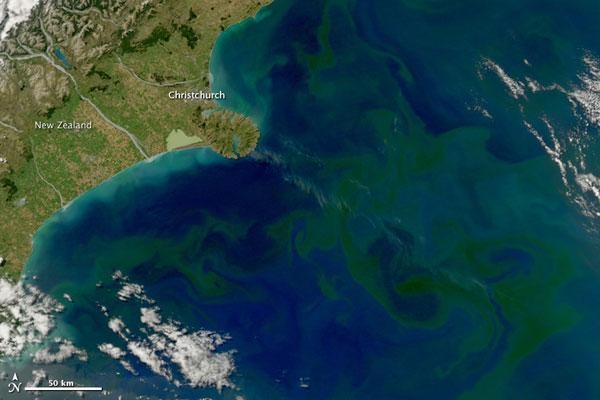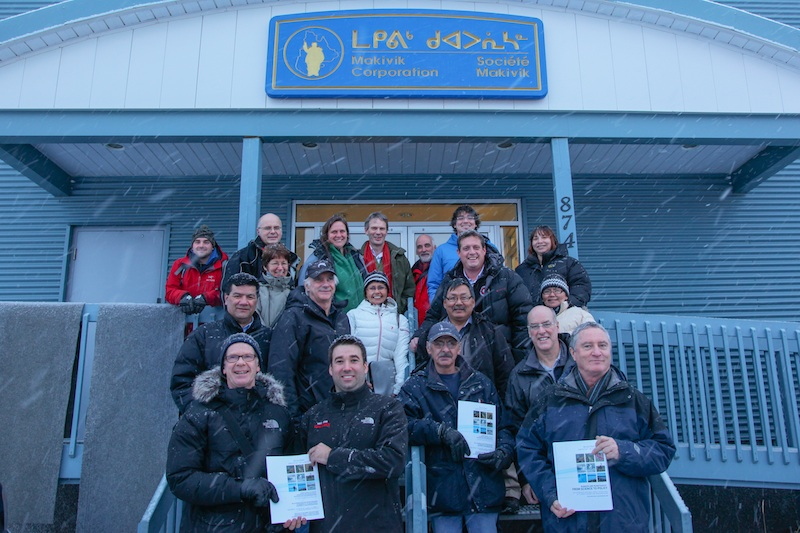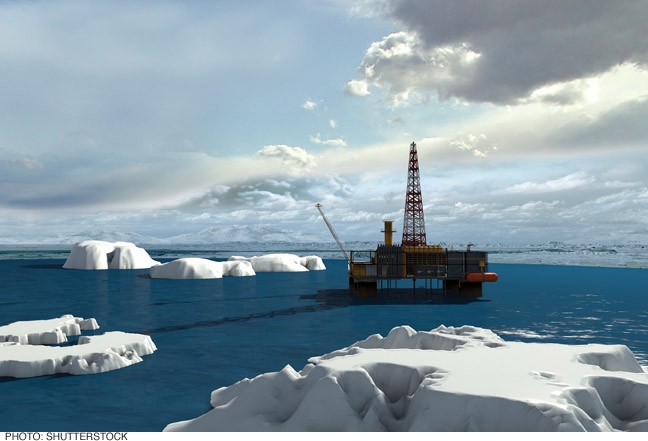
Ottawa Life Magazine’s ARCTIC SERIES: Explores the stewardship and challenges of the Canadian Arctic
The explosion onboard the Deepwater Horizon on April 20 in the Gulf of Mexico, a drilling rig owned by British oil company BP, has been dubbed by experts as the worst oil spill in the history of the United States. An estimated 2.5 million gallons of oil are leaking from the damaged pipe each day, located one mile below the ocean’s surface. As BP scrambles to find solutions to the catastrophe, with increased pressure from the US government and environmentalists, Canada’s own activity in oil drilling— specifically in the Arctic — is questioned. The images and stories from the Gulf are heartwrenching and beg the questions: could this happen in Canada’s Arctic, and if so, are we prepared? The short answers: yes, and no we’re not,” blogged Gerald Butts, CEO of WWF Canada. Five countries share a border with the Arctic including Canada, the United States, Denmark (through Greenland), Norway and Russia. This pristine northern region, a quarter of which is administered by our country, is viewed as one large resource-rich deposit of oil, gas and minerals, with more profitability as a transportation route for economic trade.

Rich in many natural resources including deposits of gold, silver, lead, copper, zinc and uranium, the Arctic also holds a quarter of the world’s remaining petroleum sources, according to the United States Geological Survey (USGS). They assessed the area north of the Arctic Circle and concluded that about 30 per cent of the world’s undiscovered gas and 13 per cent of the world’s undiscovered oil may be found there, mostly offshore under less than 500 meters of water.
Accountability and protection are needed to conserve the Arctic, where Canada’s diverse history lives on withinthe Inuit people. Issues affecting this most valued global region include sovereignty, climate change, resource exploration (including oil drilling) and water passages for trade and economic activity. Michael Byers, a professor at the University of British- Columbia, ArcticNet Network Investigator and author of Who Owns the Arctic agree. He says that “it’s time for the Canadian government to call for a moratorium on offshore drilling across the top of North America, including Greenland”. Byers believe a moratorium would give Canada time to engage the United States and other northern countries in the negotiation of a new, Arctic-specific oil spill prevention treaty.” BP promised regulators that an oil spill in the Gulf of Mexico was unlikely and would have “no significant adverse impacts.” “Unlikelyisn’tgoodenough,especially in the fragile Arctic — where we’ll only get one chance”, said Byers. The Canadian research icebreaker CCGS Amundsen in the ice of the Beaufort Sea. Opponents to a moratorium point out the current rules in Canada are very stringent. If a company is awarded an exploration lease they are not allowed to drill in Canada’s Arctic until they provide a complete environmental impact assessment to the National Energy Board (NEB) and even then, it must be approved before they can proceed. Jim Prentice, Canada’s Environment Minister has said that “the Gulf disaster has reinforced to all Canadians the importance of these strict NEB rules”.Arctic Resource Exploration is now becoming more accessible as climate change creates more passageways for commercial ships to use and opens up the Arctic to both new possibilities and new problems. The government is turning to experts to help them make the right choices.
Arctic Resource Exploration is now becoming more accessible as climate change creates more passageways for commercial ships to use and opens up the Arctic to both new possibilities and new problems. The government is turning to experts to help them make the right choices.
 ArcticNet research is recognized as having considerable authority both inside and outside government. It is a Network of Centres of Excellence of Canada (www.arcticnet.ulaval.ca) based at Université de Laval in Québec City with over 150 researcher’s from 30 Canadian Universities and 8 federal and 11 provincial agencies. They collaborate with Inuit Organizations and industry in Canada and research teams in Denmark, Finland, France, Greenland, Japan, Norway, Poland, Russia, Spain, Sweden, the United Kingdom and the USA to better understand Arctic issues. ArcticNet’s work is critical in helping Canadians understand the impacts of climate change and opportunities that come with globalization in the Arctic. Their unique integrated research is key in the training of the next generation of Arctic experts, from north and south that will play a critical role in the sustainability and protection of Canada’s Arctic. ArcticNet supports over 40 ongoing studies in natural, social and human health sciences across the Canadian Arctic.
ArcticNet research is recognized as having considerable authority both inside and outside government. It is a Network of Centres of Excellence of Canada (www.arcticnet.ulaval.ca) based at Université de Laval in Québec City with over 150 researcher’s from 30 Canadian Universities and 8 federal and 11 provincial agencies. They collaborate with Inuit Organizations and industry in Canada and research teams in Denmark, Finland, France, Greenland, Japan, Norway, Poland, Russia, Spain, Sweden, the United Kingdom and the USA to better understand Arctic issues. ArcticNet’s work is critical in helping Canadians understand the impacts of climate change and opportunities that come with globalization in the Arctic. Their unique integrated research is key in the training of the next generation of Arctic experts, from north and south that will play a critical role in the sustainability and protection of Canada’s Arctic. ArcticNet supports over 40 ongoing studies in natural, social and human health sciences across the Canadian Arctic.
Arctic Sovereignty Early explorers trekking into the treacherous cold dug their country’s flags into snow covered land, staking land claims and authority on Arctic territory. According to W.R. Morrison in the Canadian Encyclopedia, doubt has surrounded Canada’s claim to Arctic sovereignty in the islands north of our mainland. Canadian sovereignty was declared in 1903 with the erection of a NorthWest Mounted Police post at Herschel Island, enforcing Canadian laws and controlling any activities in the Western Arctic by American whalers. The US and Denmark questioned the Canadian claim after WWI, especially on Ellesmere Island but police posts in other areas followed and in 1931, Norway gave up its claim to the Sverdrup Islands, paying $67,000 for the expedition records, making Canada’s formal claim secure, according to Morrison. Currently, there are still many uninhabited and undefended areas in the Arctic, raising questions of security. Also, aside from the lands, Morrison says that Arctic waters are not seen as Canadian. With oil prospects in Alaska, the US sees these passageways as international waters, although Canada views them as internal waters where foreign ships must obtain permission to pass. Ironically, Russia makes no claims against Canadian Arctic territory. Four years ago in what was widely perceived to be provocative, a Russian military submarine planted a Russian flag at the bottom of the Arctic Ocean in a disputed area. In an exclusive interview with Ottawa Life Magazine, Russian Ambassador Georgy Maedov stated that, “we have no claims in the Canadian Arctic or in the Northwest Passage period. We are not interested. Our sovereign area in the Arctic is the Northeast Passage. The real problem for Canada’s Arctic will be the claims by our mutual friends, the Americans and interest by the Chinese.” There are four Inuit land claim regions in Canada’s Arctic. The Inuvialuit Settlement Region, Nunavut, Nunavik and Nunatsiavut are all administered by Inuit organizations and Inuit leaders. Against this backdrop, the Harper Conservative Government has developed Canada’s Northern Strategy, a 2009 report where they identify Arctic sovereignty, protecting the environment, promoting development and improving governance as the keys to retaining Canadian authority over the area. Louis Fortier, a Université de Laval Professor and scientific director of ArcticNet agrees, saying that environmental issues and sovereignty were key reasons for boosting Arctic research in recent years. “The Arctic was, and still is, warming much faster than elsewhere– and it’s in our backyard,” he observes.
Climate Change The Inuit people of the Arctic rely on caribou, seals, polar bears and muskoxen to not only feed themselves but to clothe and provide other necessities. Inuit are directly impacted by climate change caused by the burning of fossil fuels and other human activity. They are the first to witness a dramatic change in seasons, habitat and wildlife populations and behaviour. According to a report by the BBC, species like robins and mosquitoes —not previously seen in the region — are now making an appearance as glaciers melt at an alarming rate and coastlines experience increased erosion of up to100 feet per year. Inuit hunters have fallen through ice that was previously safe and many animals are faced with decreasing habitats that skew migration patterns and affect the entire Arctic ecosystem.
The Northern Sea Route and Other Water Passages for Trade and Economic Activity Frozen lakes and rivers have served as key transportation routes for centuries, providing access to otherwise inaccessible regions for humankind. By 2050, projections suggest the Northern Sea Route will have 125 days per year with less than 75 per cent sea-ice cover. This shortens access and use for transport vehicles which have traditionally relied on winter ice roads to transport goods and heavy equipment. The International Panel on Climate Change (IPCC) says the loss of summer sea ice, brought on by warming temperatures, will bring an increasingly navigable Northwest Passage and the Northern Sea Route. This will no doubt result in increased cruise shipping and the effects of that on the environment remain to be seen. However, on the other hand, it will provide the opportunity for people to see first-hand how precious and vulnerable the area is. The consequences of the oil spill in the Gulf and surrounding ecosystem will continue for years. As BP announces billions of dollars to compensate the fishermen, small businesses and other people drastically affected economically, there is no fixed number that can be applied to the cost in damages to the environment. The Gulf of Mexico disaster should be wake-up call and reminder for the Canadian government to remain vigilant when it comes to overseeing the development of the Arctic. Fragile ecosystems don’t get second chances.
University of Manitoba leads research in Arctic Geomicrobiology and Climate Change
To the naked eye, ice appears to be a cold, solid, substance, void of sustaining any sort of life. However, recent research has proven that it at the micro level, there is a lot going on and it actually hosts a great amount of activity from chemical reactions to living micro-organisms.
With the advancement of a relatively new field of science called Geomicrobiology, ice – particularly in the Arctic – is becoming a major indicator of the severity of climate change as climate change has resulted in the loss of sea ice.
Sea ice is not only vital to the north’s ecosystem, but also crucial to the rest of the globe. At the forefront of this research, is the University of Manitoba’ s Dr. Søren Rysgaard, the Canada Excellence Research Chair in Geomicrobiology and Climate Change. As part of the university’s Centre for Earth Observation Science (CEOS), he is currently conducting research in the Arctic on microbial activity and chemical transformations within sea ice and ocean sediments. The team is the first to explore the causes and consequences of climate change in the Arctic at the micro-scale.
s Dr. Søren Rysgaard, the Canada Excellence Research Chair in Geomicrobiology and Climate Change. As part of the university’s Centre for Earth Observation Science (CEOS), he is currently conducting research in the Arctic on microbial activity and chemical transformations within sea ice and ocean sediments. The team is the first to explore the causes and consequences of climate change in the Arctic at the micro-scale.
Dr. Rysgaard said he wants to merge different disciplines from the micro scale and large scale levels to evaluate the loss of sea ice and its effects on a global scale.
Investigating the micro scale, he and his team will identify what happens within sea ice and the interfaces between the atmosphere, the ice and the ocean at scales of micrometres and even nanometres.
“The reason for doing that is we believe the sea ice would affect gas and salt exchange within surface layers of the ocean. It is not fully understood what is going on…salt ice behaves very differently [than fresh water ice] because it is full of channels. When it forms, it is fresh water that is actually freezing and concentrating all the salts into smaller tubes known as brine channels,” Dr. Rysgaard explained.
These tubes and brine channels, similar to capillaries, have diameters requiring the smallest form of measurement and are home to many communities of micro-organisms as well as chemical reactions, which form the nutrient base of the food chain in the Arctic Ocean.
“The micro-organisms also living there affect the chemical reactions,” he continued. “This has huge implications for what is actually going on considering that sea ice is disappearing at alarming rates.”
The interaction between these organisms and microscopic algae determines the amount of food that reaches higher trophic levels or those living organisms sitting higher on the food chain. Little is known about this microbial process. However, Dr. Rysgaard’s recent research shows sea ice is key to removing carbon dioxide from the atmosphere as all of this activity causes the sea ice to “breathe,” pumping carbon dioxide in and out of the ocean. As temperatures warm the Arctic’s climate, many processes like this appear to also be increasing in activity.
The carbon dioxide findings will lead to calculating the rate of climate change as well as information for assessing resource development in the region and its effects on northern peoples. The team will also identify the different types of ice in the Arctic and link how these types of ice change how microbial processes occur in different parts of the Arctic throughout the annual cycle of ice formation and decay.
Dr. David Barber, director of the university’s CEOS and lead investigator of the Circumpolar Flaw Lead study, says sea ice is fundamental in the Arctic as it controls light and heat. His findings indicate that the thinning of sea ice is happening at a much faster rate than even most pessimistic predictions.
“Dr. Rysgaard’s contributions will merge my lab, made up of environmental science with the Clayton H. Riddell Faculty of Environment, Earth and Resources geoscience group, which is really an Earth material group with sophisticated instrumentation to interrogate earth surface materials like minerals, chemicals and crystals. [We will] be able to do an analysis of where those chemicals came from, what the conditions were when they were formed and how they were created over time. These things are a way to do very detailed science about the consequences of the changes in the Arctic but at a detailed level we’ve never been able to get at before,” said Dr. Barber.
As a province, Manitoba is a leader in environmental research and is the only western province with an Arctic seacoast (i.e. Hudson Bay). With Dr. Rysgaard, who also established the Greenland Climate Research Centre, this innovative research has the ability to aid the waters between Canada and Greenland. Towards this end, the Centre for Earth Observation Science at the University of Manitoba will be joining the Greenland Climate Research Centre through a new Memorandum of Understanding which will see joint academic positions, shared graduate students and shared laboratory space between the two centres.
— Next issue Arctic Net research, The Nunavut Premier on Resource Development and The Circumpolar Conference.















